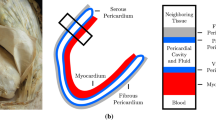Summary
It has been suggested that pericardial fluid functions as a lubricant rather than a means of transmitting pericardial pressure from one region of the heart to another. Since the functional behavior of pericardial fluid depends on fluid thickness, we measured pericardial volume and fluid distribution. In seven animals, we found that the normal canine pericardium contains 0.25±0.15 ml of pericardial fluid per kg of body weight, resulting in an average pericardial fluid thickness of only 0.34±0.27 mm. We next determined the pericardial fluid distribution in eight anesthetized mongrel dogs (17–29 kg). Color video images were recorded, while green dye (0.1 ml) was injected into the pericardial space overlying the ventricular apex to allow visualization of the pericardial fluid distribution. Within 26±17 s (range 15–53 s), dye reached the base of the heart. After 15 min of equilibration, the dye distribution appeared very nonuniform with dye accumulation over the interventricular and atrioventricular grooves. Little or no dye was present over the right and left ventricular free walls.
We conclude that pericardial fluid thickness over the interventricular and atrio-ventricular grooves is sufficient to allow fluid motion in these regions. In contrast, pericardial fluid thickness overlying the ventricular free walls is very thin. Thus, in these regions the pericardial fluid functions primarily as a lubricant: and regional variations in pericardial pressure may occur.
Similar content being viewed by others
References
Shabetai R (1988) Pericardial and Cardiac Pressure. Circ 77:1–5
Lai-Fook SJ, Price DC, Staub NC (1987) Liquid thickness vs. pressure gradient in a model of the pleural space. J Appl Physiol 62:1747–1754
Smiseth OA, Frais MA, Kingma I, Smith ER, Tyberg JV (1985) Assessment of pericardial constraint in dogs. Circulation 71:158–164
Agostoni E (1972) Mechanics of the plcural space. Physiol Rev 52:57–128
Smiseth OA, Scott-Douglas NW, Thompson CR, Smith ER, Tyberg JV (1987) Nonuniformity of pericardial surface pressure in dogs. Circulation 75:1229–1235
Hoit BD, LewWyn, LeWinter M (1988) Regional variations in pericardial contact pressure in the canine ventricle. 255:H1370
Scharf SM (1987) LV shape change with IPPV. J Crit Care 2:227
Hoffman EA, Ritman EL (1985) Invariant total heart volume in the intact thorax. Am J Physiol 249:883–890
Gibson AT, Segal MB (1978) A study of the composition of pericardial fluid, with special reference to the probable mechanism of fluid formation. J Physiol 277:367–377
Kenner HM, Wood EH (1966) Intrapericardial, intrapleural, and intracardiac pressures during acute heart failure in dogs studied without thoracotomy. Circ Res 19:1071
Hills BA, Butler BD (1985) Phospholipids identified on the pericardium and their ability to impact boundary lubrication. Annals Biomed Eng 13:573–586
Jost W (1960) Diffusion in Solids, Liquids, Gases. Academic Press Inc., New York. p27
Miserocchi G, Negrini D, Pistolesi M, Bellina CR, Gilardi MC, Bettinardi V, Rossitto F (1988) Intrapleural liquid flow down a gravity-dependent hydraulic pressure gradient. J Appl Physiol 64(2):577–584
Negrini D, Capelli C, Morino M, Miserocchi G (1987) Gravity-dependent distribution of parietal subpleural interstitial pressure. J Appl Physiol 63(5):1912–1918
Lai-Fook SJ, Conhaim RL (1987) Pulmonary interstitial resistance. Annals Biomed Engr 15:173–182
Lai-Fook SJ (1987) Mechanics of the Pleural Space: Fundamental Concepts. Lung 165:249–267
Smiscth OA, Refsum H, Tyberg JV (1984) Pericardial pressure assessed by right atrial pressure: a basis for calculation of left ventricular transmural pressure. Am Heart J 108:603–605
Slinker BK, Ditchey RV, Bell SP, Le Winter MM (1987) Right heart pressure does not equal pericardial pressure in the potassium chloride arrested canine heart in situ. Circulation 76:357
Fung YC (1977) A First Course in Continuum Mechanics. Springer-Verlag. New York: p277
Author information
Authors and Affiliations
Additional information
This study was supported in part by NIH Grant Numbers HL36068 and HL40511.
Rights and permissions
About this article
Cite this article
Santamore, W.P., Constantinescu, M.S., Bogen, D. et al. Nonuniform distribution of normal pericardial fluid. Basic Res Cardiol 85, 541–549 (1990). https://doi.org/10.1007/BF01907889
Received:
Issue Date:
DOI: https://doi.org/10.1007/BF01907889




